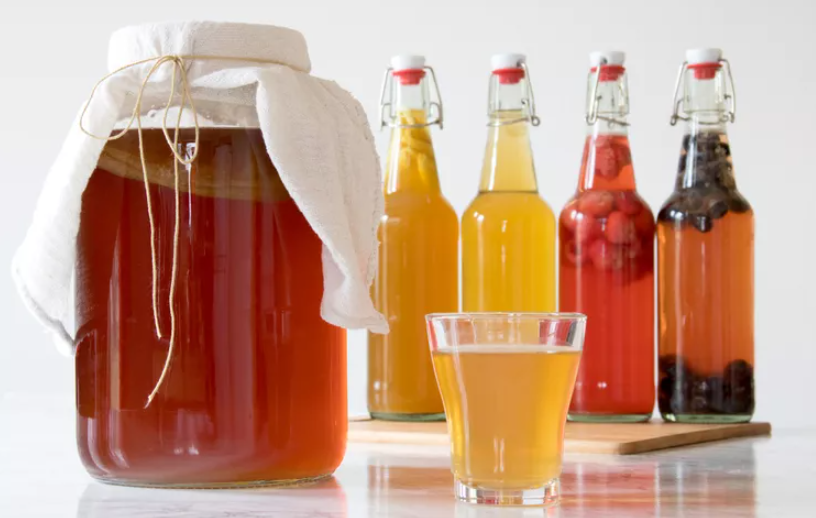
Kombucha is a popular fermented drink. Photo via The Spruce Eats
Kombucha is a fermented drink that has only recently become mainstream among the mainstream American public and its many shopping centers. The drink dates back to 221 BC, and is part of a family of fermented drinks including kvass, switchel, KOSO (a Japanese fermented drink with 100 superfoods), Jun, and more.
The base ingredient for kombucha is the SCOBY — a ‘Symbiotic Culture of Bacteria and Yeast’ that is rich in probiotics, similar to ‘The Mother’ which is found in Apple Cider Vinegar products.
Kombucha sales have risen sharply in recent years.
Companies like GT’s, Suja, Health Ade, and Better Booch have helped to bring the fermented, sparkling beverage to big box stores ranging from Target to Walmart and everything in-between.
The U.S. market for Kombucha was 2.64 billion in 2021 and is expected to nearly quadruple by 2030.
One of the questions for many people when deciding whether to purchase Kombucha is the amount of sugar it contains. What isn’t often discussed is that Kombucha and similar fermented beverages have a different effect on blood sugar than most people realize.
Kombucha, SCOBY, and Sugar
One of the most popular Kombucha brands is GT’s, made in Los Angeles, California.
A popular GT’s flavor is Trilogy, which contains 10 grams of sugar per 16-ounce bottle. This level of sugar is contained within a 40-calorie serving of the Kombucha product, much smaller than similar food and drink items with similar amounts of sugar.
Some Kombucha brands have between 15-30 grams of sugar on the bottle, which often dissuades people, especially those with blood sugar issues, from buying them (more on that later).
According to the website Kombucha Kamp, which makes at-home Kombucha kits, most of the sugar used to brew Kombucha is eaten up by the SCOBY.
The net result is a drink with a lower residual sugar content than what is typically shown on the label. The longer Kombucha takes to ferment, the less sugar the drink contains when the brewing process is finished.
Kombucha and Blood Sugar
Kombucha also contains a large spectrum of beneficial bacteria that aids gut health and digestion. The best Kombuchas typically have about 10 billion CFU (Colony Forming Units) per gram.
Kombucha made using traditional methods and Kombucha in its raw, unpasteurized state contain the most healthy bacteria.
In 2022, a study was published in the journal Foods that measured how Kombucha affected blood sugar in participants. The study was titled ‘Kombucha Reduces Hyperglycemia in Type 2 Diabetes of Mice by Regulating Gut Microbiota and Its Metabolites.’
The study found something that millions of Kombucha drinkers instinctively know — Kombucha has a different effect on health than other sugar-containing drinks.
The study showed that “Kombucha has an obvious anti-hyperglycemic (high blood sugar) effect by regulating the gut microbiota structure.”
Kombucha also lowered potentially harmful, pathogenic bacteria in the blood, which in turn lowered LPS (reactive bacterial toxin) levels in the blood, helping to reduce systemic inflammation and insulin resistance.
“The result of this study opened up a new possibility of effectively preventing and treating diabetes by intervening in the diet of patients, and also paved the way for improving the market value of kombucha,” the study concluded.
How to Get Started with Kombucha
Kombucha has been described as having a slightly bitter taste that is mostly sweet.
-Drinking a raw, unpasteurized brand like GT’s Kombucha (find it online here) is a great place to start
-Many cities have local Kombucha breweries that offer tours, taste-testing, live music and events similar to beer breweries
-Alcoholic Kombucha is also available; my favorite brand is Unity Vibration Kombucha
-Home brewing Kombucha kits are available online
Thanks for installing the Bottom of every post plugin by Corey Salzano. Contact me if you need custom WordPress plugins or website design.




